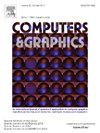VITON-DRR: Details retention virtual try-on via non-rigid registration
IF 2.5
4区 计算机科学
Q2 COMPUTER SCIENCE, SOFTWARE ENGINEERING
引用次数: 0
Abstract
Image-based virtual try-on aims to fit a target garment to a specific person image and has attracted extensive research attention because of its huge application potential in the e-commerce and fashion industries. To generate high-quality try-on results, accurately warping the clothing item to fit the human body plays a significant role, as slight misalignment may lead to unrealistic artifacts in the fitting image. Most existing methods warp the clothing by feature matching and thin-plate spline (TPS). However, it often fails to preserve clothing details due to self-occlusion, severe misalignment between poses, etc. To address these challenges, this paper proposes a detail retention virtual try-on method via accurate non-rigid registration (VITON-DRR) for diverse human poses. Specifically, we reconstruct a human semantic segmentation using a dual-pyramid-structured feature extractor. Then, a novel Deformation Module is designed for extracting the cloth key points and warping them through an accurate non-rigid registration algorithm. Finally, the Image Synthesis Module is designed to synthesize the deformed garment image and generate the human pose information adaptively. Compared with traditional methods, the proposed VITON-DRR can make the deformation of fitting images more accurate and retain more garment details. The experimental results demonstrate that the proposed method performs better than state-of-the-art methods. Our code is publicly available at https://github.com/minqili/VITON-DRR-main.

VITON-DRR:通过非刚性注册详细保留虚拟试戴
基于图像的虚拟试穿旨在将目标服装与特定的人物形象相匹配,在电子商务和时尚行业中具有巨大的应用潜力,引起了广泛的研究关注。为了产生高质量的试穿结果,准确地扭曲服装以适合人体是至关重要的,因为轻微的错位可能会导致试穿图像中出现不切实际的伪影。现有的方法大多采用特征匹配和薄板样条(TPS)方法对服装进行翘曲。然而,由于自遮挡,姿势之间的严重错位等原因,它经常无法保留服装细节。为了解决这些问题,本文提出了一种基于不同人体姿势的精确非刚性配准(VITON-DRR)的细节保留虚拟试穿方法。具体而言,我们使用双金字塔结构的特征提取器重构了人类语义分割。然后,设计了一种新的变形模块,通过精确的非刚性配准算法提取布料关键点并对其进行翘曲。最后,设计了图像合成模块,对变形后的服装图像进行合成,并自适应生成人体姿态信息。与传统方法相比,所提出的VITON-DRR可以使试衣图像的变形更加准确,保留更多的服装细节。实验结果表明,该方法优于现有方法。我们的代码可以在https://github.com/minqili/VITON-DRR-main上公开获得。
本文章由计算机程序翻译,如有差异,请以英文原文为准。
求助全文
约1分钟内获得全文
求助全文
来源期刊

Computers & Graphics-Uk
工程技术-计算机:软件工程
CiteScore
5.30
自引率
12.00%
发文量
173
审稿时长
38 days
期刊介绍:
Computers & Graphics is dedicated to disseminate information on research and applications of computer graphics (CG) techniques. The journal encourages articles on:
1. Research and applications of interactive computer graphics. We are particularly interested in novel interaction techniques and applications of CG to problem domains.
2. State-of-the-art papers on late-breaking, cutting-edge research on CG.
3. Information on innovative uses of graphics principles and technologies.
4. Tutorial papers on both teaching CG principles and innovative uses of CG in education.
 求助内容:
求助内容: 应助结果提醒方式:
应助结果提醒方式:


